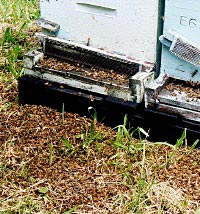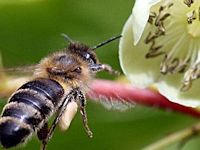Looking after pollinators
Healthy populations of bees and other pollinators are very important for the productivity of New Zealand horticulture and agriculture. You must put in place a strategy to protect polinators when you spray pesticides.

Unfortunately, many agricultural pesticides are harmful to bees and other pollinators. When bees come into contact with pesticides (and not just insecticides), the result may lead to bee deaths, contaminated honey, or reduced pollination, all of which also have an impact on beekeepers and the growers of the crops needing to be pollinated.
Legal requirements
There is a legal requirement not to apply class 9.4 (toxic to insects) if:
- bees are foraging
- plants that non-target pollinators are likely to visit are in flower or part-flower.
 |
The EPA (Hazardous Property Controls) Notice introduced a new requirement to consider all invertebrate pollinators, not just bees. |
Best practice
Before applying pesticide, you need to consider
- Plant growth stage Most bee poisonings occur when pesticides are applied to flowering crops, weeds and forest understory.
- Mixing Mixtures may be more toxic to bees The mixing of two or more sprays may alter the toxicity of the spray and negate any manufacturer product label claims.
- Relative toxicity Pesticides vary in their toxicity to bees. The toxic substance may be the active ingredient, the surfactant, adjuvant or the wetting agent in the formulation.
- Choice of formulation Different formulations, even of the same pesticide, can have variable toxicity to bees. Granular products are generally less hazardous, whereas dusts and wettable powders may stick to body hairs on bees and then be taken back to the hive.
- Residual action The rate of degradation of the pesticide is important. A pesticide which degrades within a few hours of application can be applied with minimal risk when bees are not foraging. Products with extended residual activity of greater than eight hours require extra care.
- Spray drift It may be quite safe to spray the target crop, but spray drift on to adjacent crops or weeds may pose a risk to foraging bees.
- Temperature Unusually warm temperatures in the early morning or evening may result in bees foraging when they would normally be back in their hive. However, if temperatures are unusually low, pesticide residues may remain toxic for longer.
- Distance The distance of the bee colony from the treated area is important. Bees forage on average within 1.5 to 3 kilometres of their hive, but sometimes up to 8 kilometres during a pollen or nectar shortage.
- Communication Reducing bees' exposure to pesticide requires communication and co-operation between beekeepers, growers and pesticide applicators
 You reduce the risk to bees when applying pesticides by:
You reduce the risk to bees when applying pesticides by:
- Knowing the risks
- Applying pesticides only when necessary as part of a pest management programme
- Always reading and following the instructions on the product label
- Selecting short residual and low hazard formulations
- Never treating crops in flower
- Checking nearby for foraging bees on flowering weeds and getting rid of those weeds by mowing or tillage
- Never applying pesticides during daylight hours where bees are actively foraging and pollinating
- Adjusting your spray programme to weather conditions – time of day, temperature and wind
- Communicating with your neighbours
- Communicating with beekeepers